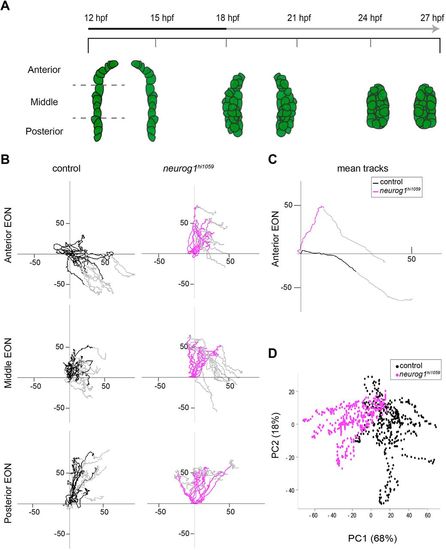Fig. 1
- ID
- ZDB-FIG-210217-38
- Publication
- Aguillon et al., 2020 - Morphogenesis is transcriptionally coupled to neurogenesis during peripheral olfactory organ development
- Other Figures
- All Figure Page
- Back to All Figure Page
|
Oriented cell movements are affected in neurog1hi1059 mutant embryos during olfactory cup formation. (A) Graphic representation of the morphogenesis of olfactory cup from 12 hpf to 27 hpf, showing a dorsal view of the three olfactory stages: olfactory territory (12 hpf), olfactory placode (18 hpf) and olfactory cup (24 hpf). EON progenitors are represented in green as visualised with the Tg(-8.4neurog1:gfp) transgene. At 12 hpf, the −8.4neurog1:GFP+ placodal domain can be divided into anterior, middle and posterior regions. The early (12-18 hpf; black) and late (18-27 hpf; grey) phases of morphogenesis are noted in the time line. (B) Tracks showing migration of EON of control (black) or neurog1hi1059 mutant (magenta) embryos. Twelve tracks are represented (two cells each from the left and right of three embryos) for each of the anterior, middle and posterior domains of the developing cup indicated in A. The origin of the tracks has been arbitrarily set to the intersection of the x/y-axes and the early (coloured) and late (grey) phases of migration have been highlighted. (C) Mean tracks for anterior EON of control (black) or neurog1hi1059 mutant (magenta) embryos. (D) Pairwise PCA scatterplots of morphogenetic parameters extracted from the datasets corresponding to the tracks in C. The major difference between control and neurog1hi1059 mutant embryos (PC1) corresponds to the antero-posterior axis. |

